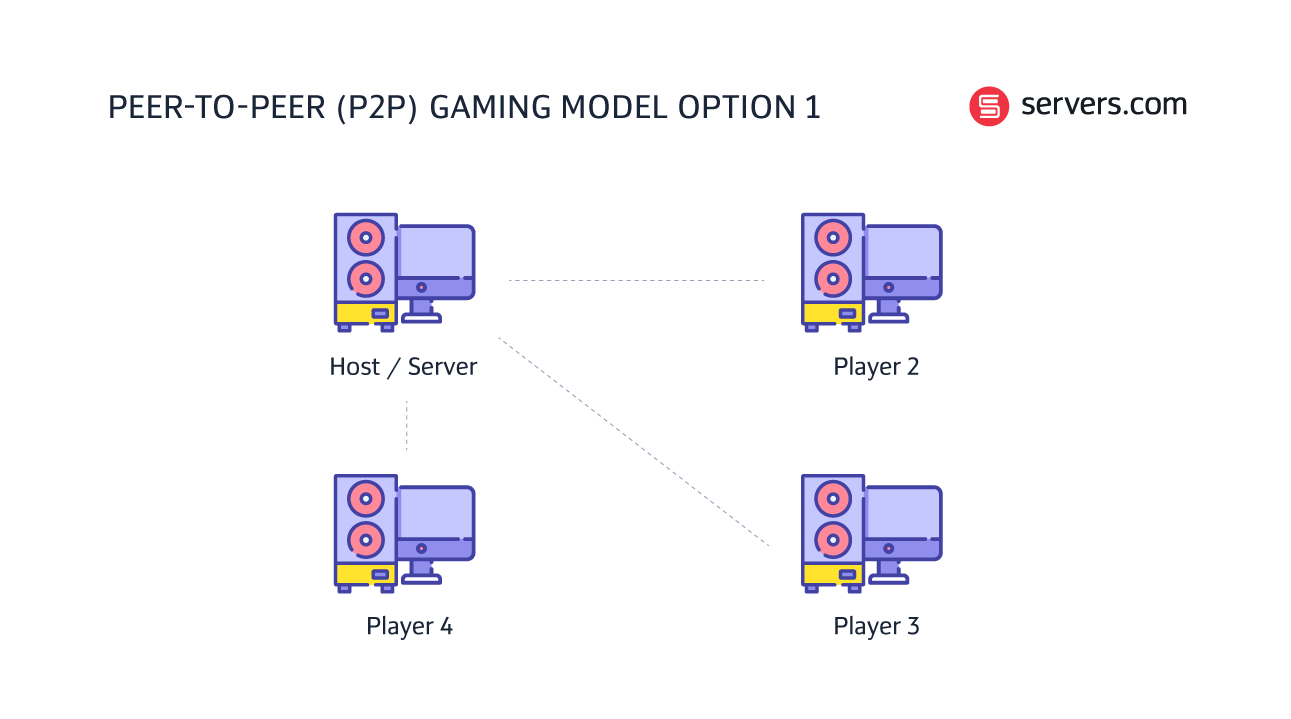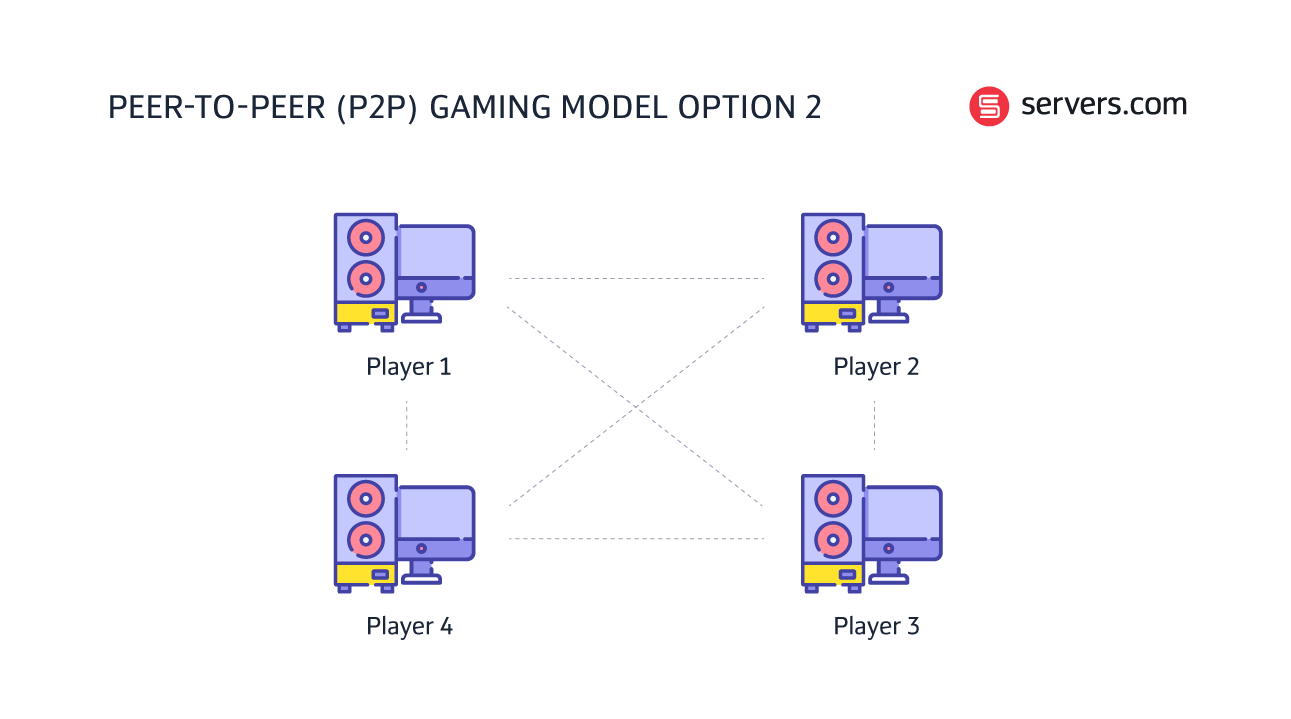![Exploring 4 Types of Game Server Hosting [+Pros & Cons]](/dA/d06db87d21/image/Article.png)
![Exploring 4 Types of Game Server Hosting [+Pros & Cons]](/dA/d06db87d21/image/Article.png)
You’ve created an amazing multiplayer game that you can’t wait to launch into the world. But before you can do so, your game needs to be hosted somewhere.
Do you opt for the dedicated resources of bare metal servers? Or do you need game server hosting that comes with additional support from managed solutions?
There are a variety of different options out there for hosting game servers. But which is the best option for you? That very much depends on your game and who its players are.
To help you make the right decision, we’ve created a handy guide to the different types of game server hosting, what they are and the pros and cons of each.
Also known as peer 2 peer or P2P, peer-to-peer hosting is the simplest and least costly of the four types of game server hosting that we’ll be discussing in this blog.
In fact, it doesn’t even use a physical server. Instead, peer-to-peer hosting relies on the players themselves connecting to one another to maintain an online network through which they play.
There are two ways that this works.
One player (usually the player with the best internet connection or the one that joins the game first) sets themselves up as the host (or the server) and the other players connect to them. Or, if it’s a public lobby, the game will automatically choose who will be the host. This is usually the player with the best internet connection. The host then relays data about the game to each player that has connected with them.

Alternatively, a group of players can set up a connection between each other, using their network of computers to balance the work needed to keep the game running.

The peer-to-peer model is a great option if your game is slow paced or it’s a single player game with a lobby shooter extension or a multiplayer game based entirely around lobby shooting.
Some of the most successful P2P games are the likes of Animal Crossing: New Horizons, Red Dead Online, GTA Online and Super Smash Bros. Ultimate.
Pros:
Cheap and easy to set up and free to maintain
No dependency on a single server
Easily scalable
Cons:
Much less secure
A good internet connection is vital. If the host has internet spikes or packet loss, all the players in that game session will also suffer
The host will always have the competitive advantage (not good for competitive synchronous/real time games)
Far easier to cheat
Can only handle up to around 10 players depending on the game
Requires players to be geographically close together for the best experience
Dedicated bare metal servers are single-tenant machines that give customers exclusive use of all server resource including RAM, disk, CPU and bandwidth.
There are three different ways of hosting games on bare metal servers.
1. On-premise – the server (or servers) are physically hosted on-site within the game studio’s premises. This is usually within an office or in the basement of the office building.
2. Co-location – hosting providers of co-location have data centers with empty racks that they will rent to you for a monthly fee that covers the space and power. The rest is up to you. You need to source and purchase the bare metal servers, configure them and then manage the ongoing monitoring and maintenance. You will also need to develop and manage relationships with ISPs for internet connection, and source hardware such as networking and routing. The provider of the co-location space won’t interact with the customer’s hardware unless they pay for additional assistance which is often referred to as ‘remote hands’.
3. Infrastructure-as-a-service (IaaS) – removes the need to purchase hardware and the big upfront cost that entails. With IaaS, game studios can rent dedicated bare metal servers from an IaaS company, who will deploy the servers including the operating system, security and internet connections and then manage ongoing maintenance.
Pros:
Complete control over hardware choice and configuration
Direct access to hardware in case of issues
Completely independent from other infrastructure providers
Can be a cost-effective option if you buy your hardware second-hand
Cons:
Significant upfront costs to purchase hardware
Overheads of expertise needed to set up and manage on-premise environment
One point of failure
Scalability is slow – if you want to grow your player numbers or if a server fails it can take weeks to replace or add more machines unless you have spares to hand
Pros:
Highly secure thanks to multiple layers of security within a data center environment
Economies of scale, sharing the costs of cooling, connectivity and power
Professional set up carried out by experts
Optional access to on-site ‘remote hands’ support (vs on prem)
Cons:
Requires significant upfront outlay to purchase the hardware
One point of failure if the data center goes down
Scalability reliant on space in the data center and time to procure new hardware yourself
Difficult to scale down if the capacity isn’t needed (e.g. game isn’t as successful as expected). This lack of flexibility is not ideal considering it’s impossible to predict exactly how many players you’ll get at launch
Pros:
Outstanding value for a stable CCU pattern
Can be scaled down easily, meaning more flexibility and less risk
Connection to a high-performance network for low latency and reliability
Dedicated game servers’ resource is uncompromised by other tenants (vs cloud)
No need to maintain the welfare of the servers unlike co-location
Cons:
Require in-house expertise to manage the server environment post-deployment (vs managed)
Can’t scale as quickly as cloud instances
Cloud servers are virtual (rather than physical) servers that run in a cloud computing environment. They are created using virtualization software (also called a hypervisor) which splits a physical server into multiple virtual servers. The virtual machines are accessed via a network, which is usually the internet, from anywhere in the world.
Cloud servers can be provisioned on-demand, making them a great option for launch days when players numbers are unknown or for peak times when traffic surges.
One of the biggest issues with cloud servers, however, is cost. What appears to be a good deal at the beginning can quickly become expensive, especially when live environment traffic is factored in. That said, the free credits that most cloud hosting provides offer are worth considering for developers and publishers looking to develop a new game. Just be aware that you will want to look at alternative, more cost-effective hosting options leading up to and following launch to ensure that your baseline or stable CCU costs don’t become unaffordable.
Pros:
Easy to scale up and down
Pay for what you use
Dedicated virtual machine resource
Simple to set up
Free credits for new customers
Cons:
Shared hardware and resources leading to lower performance cores
It’s expensive and there are lots of hidden costs such as bandwidth and storage
Support is very limited. Standard support is generally break-fix only and better support is available but is an additional percentage on top of your bill every month
Hybrid hosting gives you the option of combining different types of infrastructure hosting to suit the specific needs of your game.
For example, you could use cost-effective dedicated bare metal servers for your more consistent and stable CCU numbers alongside highly scalable virtual machines that cover burst capacity at peak times. This approach allows you to maintain the performance of your infrastructure set up to ensure the best player experience while optimizing costs and scaling easily during peak times.
There are two ways of implementing hybrid infrastructure hosting:
1. Managed hosting – you will likely be very familiar with some of the big names in the managed hosting world – Unity (Multiplay), Nitrado, Gameye and Accelbyte. They specialise in working with game studios to manage hybrid infrastructure environments. From helping with the procurement of servers to managing a studio’s full infrastructure stack, including integration of the game engine, matchmaker, databases etc. Simply send them your game files and they’ll set everything up.
Working with a managed hosting provider to create a hybrid environment is a fantastic option for all game studios. It is a particularly good option for small to mid-sized game studios that don’t have an in-house tech team to manage infrastructure or bigger companies that simply don’t want the hassle of procuring and managing their own infrastructure.
2. Do it yourself – creating a hybrid server environment to host game servers requires a lot of work to pull together, including developing and managing relationships with multiple infrastructure and service providers. However, this approach gives game studios the opportunity to build an infrastructure stack that is designed specifically for their needs and means they will have full ownership and control.
A game studio could, for example, work with three different hosting providers for dedicated bare metal servers, hyperscale cloud and co-location. From there they have a few options. They could:
Build their own game orchestration, matchmaker and autoscaling system
Work with a service provider that is an expert in each of these areas and either:
Use their software and ask them to manage it
License their software for greater ownership and control of how that software is used
These are just two potential approaches. In fact, the possible set up options for creating a hybrid environment are endless. Like deciding whether to build a game in an already established game engine vs building your own engine that will be designed specifically for your needs and will increase your time and cost of development. It all depends how much you’re willing to take on vs how much bespoke customisation you’re willing to compromise on.
Pros:
Takes away the workload of managing your own infrastructure
Enables you to scale in line with your daily CCU and regional swing graphs
Focus on your game, not the infrastructure needed to host it
Access to additional value-add services
Expert support for complex server set-ups
Cons:
The additional level of managed support comes with a high price tag
Lose a small level of control and ownership over your data
Pros:
Completely customized hybrid infrastructure set up
Have full control and ownership of your data
Cons:
Overheads of expertise needed to set up and manage environment and/or software
Time required to set up and manage environment
None of these different hosting options are better or worse than the other. Which one you choose depends on the specific needs of your business, team, game and its players. We hope this guide gives you a good overview of the options that are out there and helps you make a more informed decision when you come to launching your game.
Looking for something specific? Get in touch and we’ll be happy to help.

Hannah is an experienced communications professional, with a decade-long career developing memorable campaigns for some of the world's biggest technology companies. She has a keen eye for detail and flair for creativity.